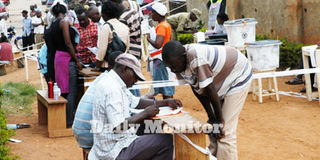Uganda’s ability to pay debts drops to negative

Voters line up to vote. Political uncertainity ahead of the the 2016 general election has seen the country drop in credit rating. PHOTO BY FAISWAL KASIRYE
What you need to know:
Reason. Political uncertainity due to elections cited as a major factor.
Kampala. Political uncertainty ahead of the 2016 general election is one of the reasons why Uganda’s credit rating has been downgraded from stable to negative. A credit rating for a country is an assessment on its ability to pay its debts.
Moody’s, a credit rating agency, revealed the current political environment had fastened the outflows of the much-needed investment due to uncertainty.
“Increased political uncertainty as the presidential elections approach has exacerbated external vulnerability, accelerating capital outflows in an already volatile emerging market environment,” the Moody’s rating released over the weekend reveals.
In March 2015, Moody’s had given Uganda a stable rating based on “healthy growth prospects and solid public finances.”
Those prospects have since dwindled with the economy already expected to grow at 5 per cent from 5.8 per cent that was initially projected.
This as Bank of Uganda (BoU) tightened its monetary policy stance in order to curb any inflationary pressures.
“The fiscal deficit is now expected to average 6 to 7 per cent of GDP for the next few years, nearly double its average since 2011. Combined with the sharp weakening of the exchange rate, we expect that this will drive up the government debt burden to an estimated 39 per cent of GDP in 2015,” Moody’s noted in its review.
Moody’s indicated that interest payments on domestic debt have all increased for the 365-day treasury bills rose to 19.1 per cent in October 2015, up from 12.1 per cent in December 2014.
This means the interest payments that Uganda will have to pay on what it borrows will rise in the next financial year.
Decline
Moody’s has also revealed that the Shilling depreciation and public expenditure had led to a decline in foreign reserves to $2.7b in September 2015. That is a figure “below the threshold of four months of imports for the first time since 2011.




